| |
Monday, March 31, 2008, 1:16 AM GeneralPosted by stefanie Earlier today, I had lunch with my koto teacher and her other students. After the lunch, the Japanese students showed the three foreign students how to wear kimono, the traditional Japanese robe. Getting into full kimono is an elaborate process, so they only did simple kimono for us. Here, the women are working together to tie another student's obi: 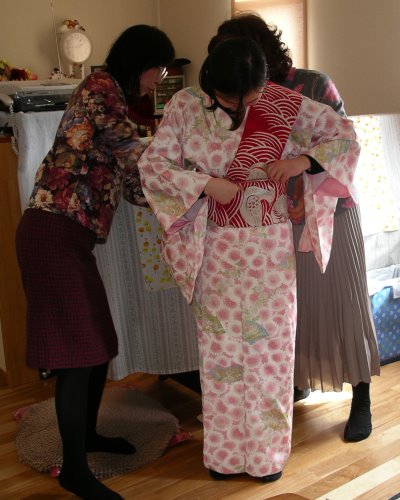 And here's an example of the finished product: 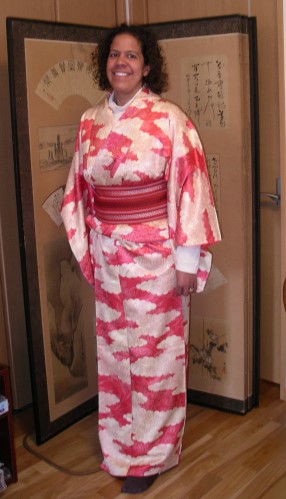 I'm told that the clouds-and-flowers pattern on this kimono is a classic one. The colors are beautiful, aren't they?
Sunday, March 30, 2008, 2:40 AM GeneralPosted by matthew It was one year ago today that I woke up for the first time in Kitakami. I'd arrived the afternoon before, met some co-workers, and gone shopping for a handful of essentials — a futon to sleep in, a towel so I could take a bath. I had a busy day ahead (orientation at work and more shopping), but I was excited, so I had no trouble getting up and getting ready. Then I stepped outside into this: 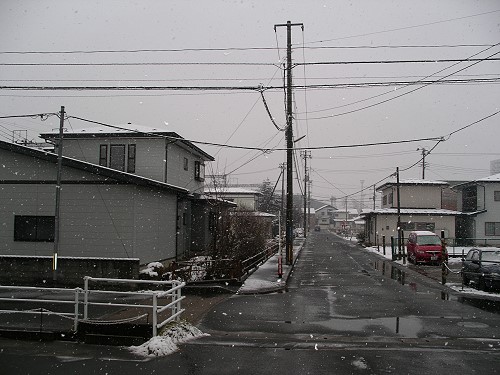 Welcome to Kitakami! Here's your first snow. That kicked off what has surely been one of the most exciting and educational years of my life. A year ago, this adventure had just begun. A year before that, it had not yet been conceived — we were still planning our vacation in Japan. I can't help but wonder what will happen in the next year, and I can hardly wait to find out.
Wednesday, March 26, 2008, 2:07 AM GeneralPosted by stefanie A couple of months into our stay here, a friend from America called to chat. I answered the phone: " Moshi-moshi?" The line was silent for a minute, then our friend started laughing. "You answer the phone like a Japanese person!" No one would mistake us for native speakers, but it seems that our voices change when we speak Japanese. We don't sound like "Matthew and Stefanie using their normal voices to speak a foreign language," like we do when we're speaking French or Spanish. Matthew speaks in a lower tone and more quickly than he does in English. My voice gets a bit higher and more nasal, and quite singsongy. The changes are more noticeable when we're very comfortable with whatever we're saying, like basic pleasantries or talking about the dogs. It's even true when we're stumbling through less familiar topics, though. We use Tohoku-ben with some frequency, and our speech is littered with the vocalized pauses more common to Japanese than English. A lot of the change is probably due to being immersed in the language. When you're studying a foreign language in isolation, you don't have a chance to pick up the little things from everyday speech — the shortcuts and attention-indicators that native speakers do. If you don't hear the language every day, you can't get the natural rhythm and intonation that native speakers use. Also, you don't get many of the gestures that accompany certain types of speech (like shaking our heads while waving one hand, palm facing out, when we answer a question in the negative). After months of repeated exposure, you naturally start to incorporate these things into your everyday speech. We didn't expect to pick up second voices when we moved here. We wonder whether they'll return to America with us, or somehow influence our native tongue. Heck, we even wonder what mannerism we'll pick up next.
A few weeks ago, our friendly local liquor store owner / school landlord invited us to take a tour and tasting at a local sake brewery, Kikuzakari. It's a small brewery that has been in the same family for generations. The current president is the founder's great-great grandson, and he took us on the tour personally. One thing that's obvious when you tour a sake brewery is that OSHA holds no sway here. Workplace safety is your own lookout. Even customers taking a tour are expected to look out for themselves, walking about in poor lighting on wet floors, stepping over the hoses and wires strewn everywhere. 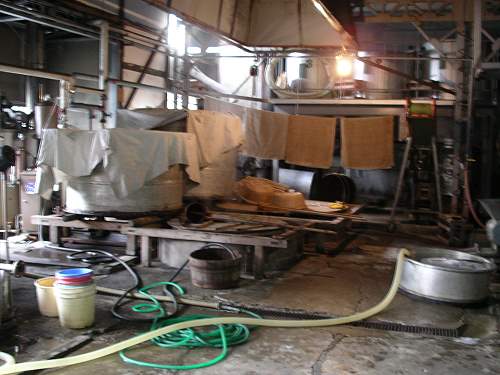 Of course, it was well worth it just to get to spend time surrounded by the yummy yeasty smell of brewing alcohol. It was heavenly. At one point we got to try the somewhat sweet and tart raw sake from a vat that was just about ready for filtering and bottling. Being a small brewery, many tasks that would be done by machine at a large brewery are done by hand. The day we were there, this guy was gluing the labels to the bottles. It's not a very exciting job — grab a crate, wipe all the bottles clean, spread glue on a label, carefully line it up and press it in place, move on to the next bottle — but I guess somebody has to do it. 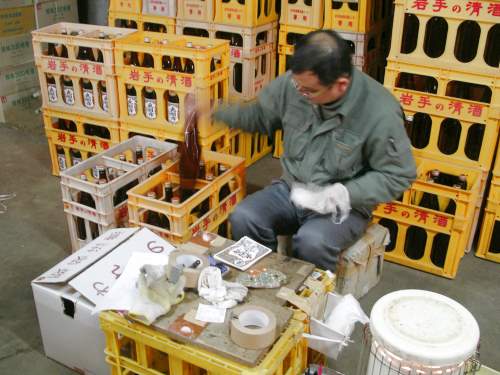
Thursday, February 21, 2008, 1:59 PM GeneralPosted by stefanie Winter festivals are quite popular in Tohoku, especially in places like Hokkaido and Akita, where a lot of snow falls. On Saturday, we went to the festival of Kamakura in Yokote, Akita Prefecture. Kamakura are huts made out of piles of hollowed-out snow. Inside the large ones, there are altars to honor the water god. People present offerings of sake, mikan, and rice cakes and ask for plentiful rain during the planting season. At night, local children sit inside the kamakura and invite passersby in to eat grilled mochi and drink amazake. It's a very happy thing to walk among the community of snow huts and chat with the children inside. We started our day with a visit to Yokote Castle. The path to the castle was lined with unlit kamakura. 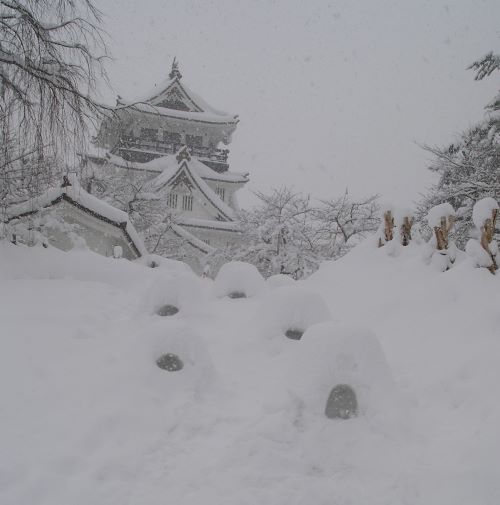 The festival really got underway after dark, when the candles could be lit, making the kamakura glow. 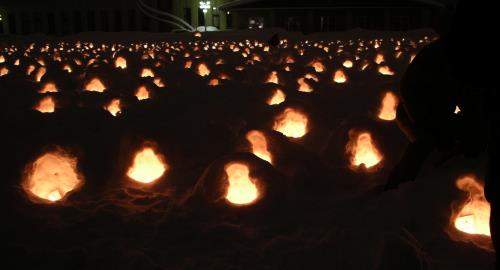 Of course, we accepted an invitation for mochi and amazake. 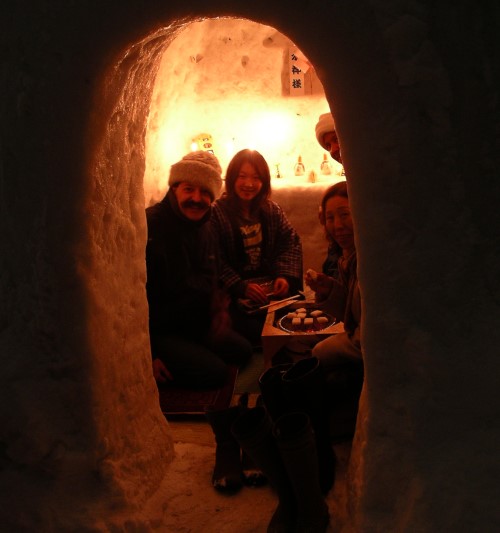 Even for a kamakura, you have to take your boots off in the genkan ¡½ you don't want to get snow on the blankets lining the floor.
Tuesday, February 19, 2008, 1:07 PM GeneralPosted by stefanie I turn 33 this June. According to the Japanese age system, I'm already there and therefore in need of protection. For women, 33 is a major yakudoshi, or "age of calamity," as one reading of the number 33, san-zan, means "horrible" or "difficult." (For men, the age of major calamity is 42 because one reading of the number, shi-ni, is a homophone for the Japanese word for "death.") The year before ( maeyaku) and the year after ( atoyaku) one's yakudoshi are also unlucky years. So basically, the most unlucky years of my life span the entire time we're living in Japan. Awesome. My yakudoshi luck made itself apparent at noon on Sunday. A few weeks ago, I had signed up to participate in our area shrine's yakudoshi ceremony. Two hours before the ceremony, a couple of the community leaders came to the house with the following explanation for how things would go down: "You'll be first because you're the only thirty-three-year-old. Also, and we're really, really sorry for the late notice, but could you give a speech? It can be easy! We're really sorry to tell you this now. Thank you so much. Did we mention that we're sorry about springing this on you two hours before the ceremony?" One frenzied phone call to my Japanese teacher and a consultation with the neighbors across the street later, I had a short, sweet speech prepared. At the ceremony, a Shinto priest prayed for the good health and fortune of the people celebrating their yakudoshi.  Members of the community gave those of us participating in the ceremony red hats after the blessing. 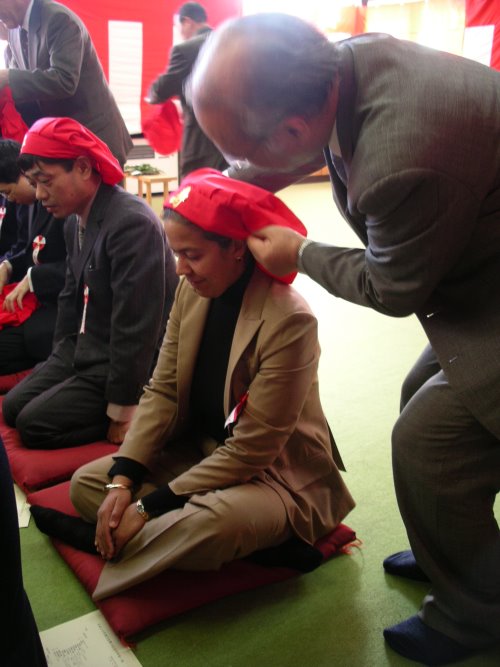 Once the ceremony had concluded, the community members and celebrants had a party with lots of drinking, eating, and well-wishing. My speech went very smoothly, perhaps helped along by the well-wishers plying me with beer. The community leaders made the forty-two-year-olds and me (and Matthew, just for kicks) dance a traditional dance. 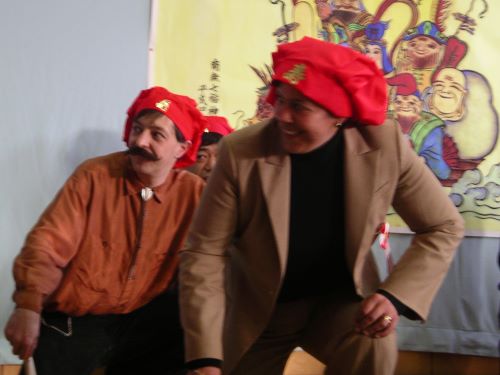 It was a very special day, and we had a great time.
Yaki = Grilled = Food... Right?
At Inukko Matsuri, we decided to enjoy some of the festival food for dinner. But what to have? Pretty much every food item available was something yaki - grilled or fried. There was takoyaki (octopus in fried balls of batter), yakiniku (grilled beef skewers), okonomiyaki (fried pancake with toppings), ikayaki (grilled squid), yakizakana (grilled fish), yakisoba (fried noodles) with or without medamayaki (fried egg), yakimochi (grilled mochi), yakitori (grilled chicken skewers), and yakidango (grilled rice flour balls). Other foods such as nabeyaki udon (fried noodle hot-pot), sukiyaki (simmered morsels), teriyaki (meat or chicken with a sweet sauce) and yakiimo (grilled sweet potato) were not represented at the festival. As we considered our options, we saw a tent set off from the others a little ways, advertising dondoyaki. What kind of food might that be? We'd never heard of it, but thought it would be best to check it out before deciding what to eat. As we approached the tent, it became apparent that food was not involved. They actually seemed to be collecting pine branches. Then it dawned on us that yaki isn't just for food - it also means burning things. In fact, they were collecting new year's decorations to burn in a bonfire as part of a Shinto ceremony. 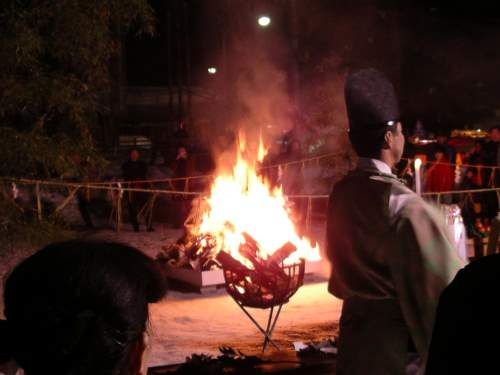 Needless to say, we opted for some of the other yakis for dinner.
Tuesday, February 12, 2008, 12:03 AM General, DogsPosted by stefanie This weekend was Inukko Matsuri in Yuzawa City, Akita Prefecture. Inukko Matsuri, the "Little Dog Festival," dates back to the Edo Period (about 400 years). It is said that the festival originated after the feudal lord of what is now Yuzawa City defeated a clan of thieves. To protect their homes against future thievery, the townspeople put small dogs ( inukko) made of rice flour in the entryways and windows of their homes. For the matsuri, groups build shrines out of snow, at the altars of which they place candles, offering boxes, and inukko. 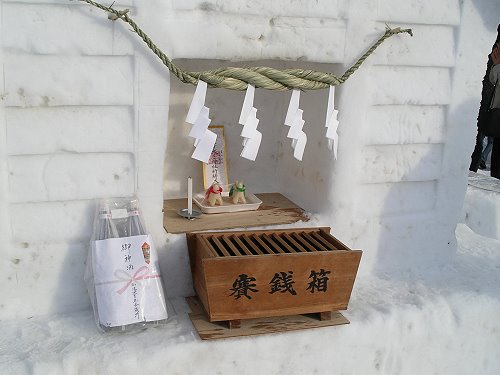 The shrines have much larger guardians as well: 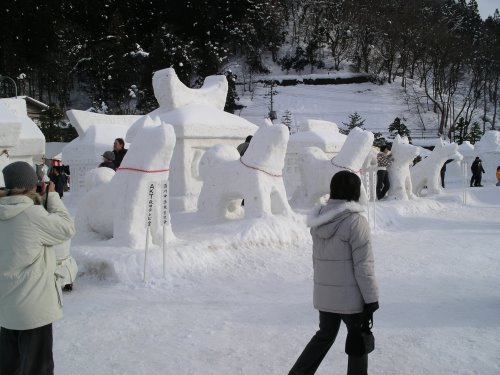 At night, the shrines and dogs are lit by candles, giving the whole park where the festival is held a magical, wondrous feeling. 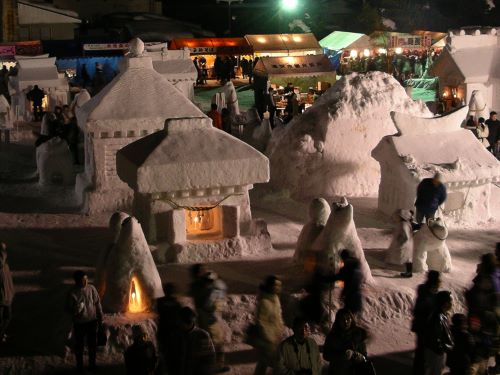
Saturday, February 9, 2008, 1:17 AM GeneralPosted by stefanie "Who do you like: Clinton or Obama?"
Over the last couple of weeks, this question has come up a few times. Especially this week, after Super Tuesday, when more people have asked us our views. People in Kitakami are clearly watching the American presidential race this year.
Clinton and Obama are far and away the names that people ask us about most often. We read American news sources every day, so we're very aware that the American media highlights their historical significance as presidential candidates. It appears from talking to people here that Japanese media is focusing on that aspect of the presidential race as well. As a result, the Republican candidates hardly register at all. Most people don't even ask about them. During a discussion about the election, one person was able to name McCain and Giuliani, but knew nothing about the other Republicans. He only vaguely knew about John Edwards. It will be interesting to see whether people ask more about the Republican candidate once both parties have chosen their nominees.
In the interest of keeping the blog's focus on our lives in Japan, please do not comment on the candidates in the comments section.
[ 1 comment ] permalink
Yesterday was Setsubun, the day before the beginning of the "spring season" in Japan. Setsubun is a day akin to New Year's, when people engage in rituals to chase evil away from their homes and bring good fortune in during the year. The most famous ritual is mamemaki, or "bean throwing." Mamemaki involves the head of the household throwing beans out the door of the home at someone dressed as a demon, while the family members chant: " Oni wa soto! Fuku wa uchi!" ("Demons out! Good luck in!"). You're also supposed to eat one bean for each year of your life to bring good luck. Here in Kitakami, stores were selling peanuts to be used for mamemaki, rather than soybeans. We didn't do mamemaki at home (scaring demons away is why we have big fuzzy dogs), but we did partake in the ritual of eating ehomaki at Hige-oyaji's place. This tradition allegedly originated in the Kansai region, but has spread to other areas of Japan. Ehomaki is a fat sushi roll (called futomaki on non- Setsubun days). If you can eat the entire uncut roll while praying, and without speaking, it is believed that you will have good fortune throughout the year. You eat the ehomaki while facing the eho (direction of good fortune) for the year. The eho is determined by the year of the Chinese zodiac; this year, for the year of the mouse, the direction was south-southeast. Hige-oyaji had a fancy Setsubun compass, set with zodiac symbols and their related directions, to tell us what direction to face. Unfortunately, I didn't completely understand what was going on, so I ate most of my ehomaki facing a wrong direction. Oops.
Back Next
|
|

















 Calendar
Calendar




